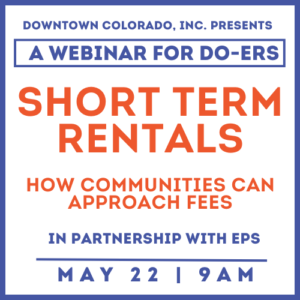Managing Short-Term Rentals
Presented in partnership with Economic and Planning Systems
May 22, 2024
Watch the Webinar with this LINK
HOW DO SHORT-TERM RENTALS IMPACT HOUSING AND LODGING IMPACTS?
Short-term Rentals (STRs) are a key addition to the lodging mix, especially in communities where there isn’t a robust hotel or motel stock. In these communities, STRs are a key component in allowing tourism to grow. The question is how to balance the practices and impacts on local affordable housing, supporting property owners in offsetting costs of ownership, and tourism as an economic driver.
Benefits of STRs
- Add capacity to lodging inventory
- Generate local revenue (sales tax, lodging tax, excise tax, fees)
- Guests spend money in the local economy
- STRs can offset the costs of homeownership
Drawbacks of STRs
- May remove some affordable housing options from the market as potential revenue differences can incentivize using homes for STR rather than permanent residence.
- STRs may draw away from other lodging and create challenges for communicating with visitors in the community.
- Additional visitors to the community may draw on the use of local infrastructure.
Local affordable housing needs are influenced by both supply and demand pressure from short-term rentals. Often, units are converted to short-term rentals as owners believe the market for three days a week might yield more revenue than a long-term lease. Similarly, there are owners who cannot afford the mortgage on the unit or space they use for their residence without the additional income.
Policy issues revolve around neighborhood character, quality of life, the local economy, and housing.
WHAT DOES IT MEAN FOR DIFFERENT COMMUNITIES?
Non-Resort Rural: Positive economic benefit, potential for large community impact.
Resort/Mountain: Critical for lodging inventory, creating housing needs.
Metro Area: STRs are less common, and managing community impact is important.
Large City: STRs provide different visitation options and can impact the housing supply for residents.
Approaches center around:
- Licensing. The key starting point is understanding the number and placement of STRs. Licensing is the key first step because it allows the community to develop an inventory of how many and where the STRs are in the community. This can be expanded to limit the number of STRs, specialize with STRs only for primary residences, or allow so many licenses in certain geographic areas, e.g., where tourists want to shop. This may include license fees to offset the costs of managing this program.
- Zoning. Zoning is how we shape where and how many licenses might be located. This allows the community to focus on where guests are ideally going to visit or where we want to limit impacts on local residences. This might include minimum buffers between STR units.
- Regulatory Fees, Taxes, or Timing. Fees can offset the expenses of managing the program or accommodating visitors. Fees can vary by bedroom or stay.
- Administrative Fees: Costs for the municipality to manage the program.
- Housing Impacts: Can support local housing programs through the need to serve the accommodations and service employees required by tourism, environmental clean-up, and community maintenance.
Several Colorado Communities have STR fees, many of which are mountain communities. The highest is Estes Park, with a $1,500 per unit fee, and the lowest is Aurora, at $43 per unit. Some fees are per bedroom, likely mountain resort communities. Many communities simply charge a business license rate.
Other policies used by communities include:
- “Good Neighbor” Guide in units
- Targeted enforcement (e.g., garbage, noise)
- Dedicated complaint/code enforcement
- Requires a local contact
Five steps to an effective STR strategy:
- Be proactive by licensing units
- Understand the role STRs play in the housing/lodging inventory/market
- Understand the benefits and drawbacks of STRs
- Decide what tools would be most appropriate to address the impacts
- If raising revenue, have a plan to spend it
Questions & Answers:
Q: Are there statewide efforts to track the impact on lodging?
A: The State made a deal with Airbnb to collect lodging tax. Efficient collection of fees. There’s a large difference between residential and commercial taxes and costs in Colorado. It is difficult to close this gap and hard for county assessors to measure.
Q: Locals report that STR policy doesn’t impact local housing capacity.
A: It depends on the community and the product used for STRs. This scenario is true for only a percentage of communities but is not universally true across neighborhoods or communities. The type of housing product is important to consider in the response.
Q: Our council wants to create an STR policy and increase regulation, are there limits on caps under the statute?
A: There are active lawsuits against regulations in some communities. When communities demonstrate through existing policies for local housing, they stand a better chance of defending the regulations. Guests are a beneficiary of the fees, because it helps to create a more beneficial tourist/visitor experience.

